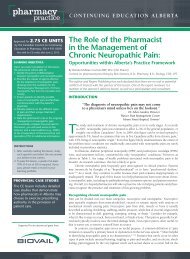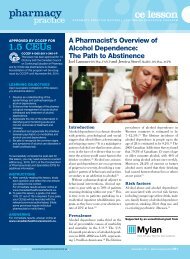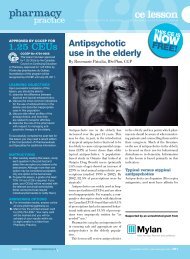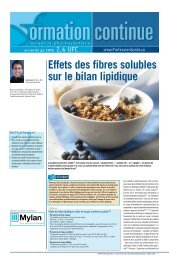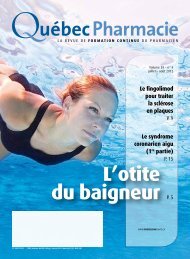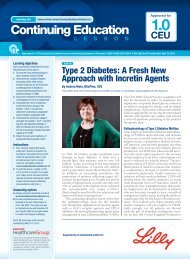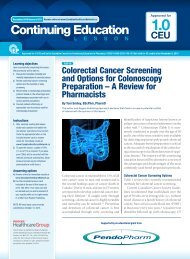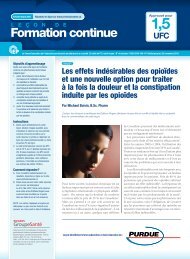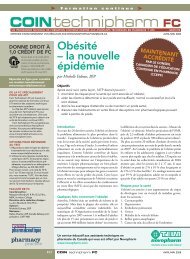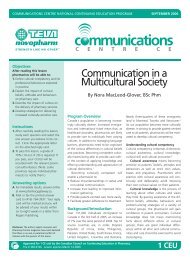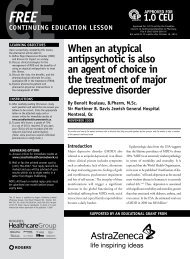Communication in Pharmacy Practice: An Overview
Communication in Pharmacy Practice: An Overview
Communication in Pharmacy Practice: An Overview
Create successful ePaper yourself
Turn your PDF publications into a flip-book with our unique Google optimized e-Paper software.
COMMUNICATIONS CENTRE NATIONAL CONTINUING EDUCATION PROGRAM JUNE 2006C E N T R E C EObjectivesAfter read<strong>in</strong>g this lessonpharmacists will be able to:1. Describe different learn<strong>in</strong>g stylesand how this may <strong>in</strong>fluencepatient teach<strong>in</strong>g.2. Describe elements of verbal andnon-verbal communication.3. Identify barriers <strong>in</strong> your practicethat <strong>in</strong>fluence communication.4. Expla<strong>in</strong> the importance of empathy<strong>in</strong> patient communication.5. Evaluate their communication style.Instructions1. After carefully read<strong>in</strong>g this lesson,study each question and select theone answer you believe to be correct.Circle the appropriate letteron the attached reply card.2. To pass this lesson, a grade of70% (14 out of 20) is required. Ifyou pass, your CEU(s) will berecorded with the relevant prov<strong>in</strong>cialauthority(ies). (Note: someprov<strong>in</strong>ces require <strong>in</strong>dividual pharmaciststo notify them.)<strong>An</strong>swer<strong>in</strong>g optionsA. For immediate results, answer onl<strong>in</strong>eat www.pharmacygateway.ca.B. Mail or fax the pr<strong>in</strong>ted answercard to (416) 764-3937. Your replycard will be marked and you willbe advised of your results with<strong>in</strong>six to eight weeks <strong>in</strong> a letter fromRogers Publish<strong>in</strong>g.Disclosure: The author, expert reviewers and<strong>Pharmacy</strong> <strong>Practice</strong> magaz<strong>in</strong>e have each declaredthat there is no real or potential conflict of<strong>in</strong>terest with the sponsor of this lesson.<strong>Communication</strong> <strong>in</strong><strong>Pharmacy</strong> <strong>Practice</strong>:<strong>An</strong> <strong>Overview</strong>By Nora MacLeod-Glover, BSc PhmProgram <strong>Overview</strong>Effective patient communication is centralto be<strong>in</strong>g able to provide pharmaceuticalcare: identify<strong>in</strong>g patient issues and needs,develop<strong>in</strong>g and communicat<strong>in</strong>g solutionsand ensur<strong>in</strong>g patient agreement andunderstand<strong>in</strong>g are essential skills for pharmaciststoday. Effective communicationskills are necessary for practitioners toreceive accurate and comprehensive <strong>in</strong>formationfrom the patient as well as successfullyeducate the patient. Additionally,strong communications skills will enable apharmacist to:• Establish the necessary rapport to build<strong>in</strong>ga trust<strong>in</strong>g relationship; and• Ensure an effective exchange of <strong>in</strong>formationnecessary for the pharmacist toappreciate patient needs and for thepatient to understand and accept pharmacistrecommendations.The purpose of this lesson is to providepharmacists with the fundamentals of communicat<strong>in</strong>geffectively so that they can ultimatelyprovide better patient care. Some ofthe more tangible benefits patients experiencewhen pharmacists use effective communicationstrategies: 1• Improved adherence with medication use• Increased satisfaction with their relationshipwith the pharmacistApproved for 1 CE unit by the Canadian Council on Cont<strong>in</strong>u<strong>in</strong>g Education <strong>in</strong> <strong>Pharmacy</strong>.File # 336-1105. Lesson expires November 30, 2008.• Greater likelihood that patients will askfor help when it is needed, result<strong>in</strong>g <strong>in</strong>fewer unaddressed side effects andadverse effects.• Improve patient trust <strong>in</strong> pharmacistadvice and education.Background/IntroductionCommunicat<strong>in</strong>g–know<strong>in</strong>g versus do<strong>in</strong>gKnow<strong>in</strong>g how to communicate and be<strong>in</strong>gan effective communicator are different. Itis important to understand how to communicate<strong>in</strong> order to be an effective communicator.This lesson will provide <strong>in</strong>formationabout communication theory along withhow and why it is important. Just as weneed to understand the rules of golf or tennisbefore we can play, so must we appreciatethe elements of communication. <strong>An</strong>dlike learn<strong>in</strong>g to play tennis or golf, be<strong>in</strong>g aneffective communicator takes practice andrequires a deliberate effort to manage our<strong>in</strong>teractions with others.A skill we can all learnWe can all learn how to become more successfulcommunicators. In this lesson youwill encounter reflective exercises to enableyou to th<strong>in</strong>k about how you can apply the<strong>in</strong>formation to <strong>in</strong>crease your effectivenessas a communicator.1 CEU
2 <strong>Communication</strong> <strong>in</strong> <strong>Pharmacy</strong> <strong>Practice</strong>: <strong>An</strong> <strong>Overview</strong>COMMUNICATIONS CENTRE CE • JUNE 2006How we communicate<strong>Communication</strong> <strong>in</strong>volves several activities.We communicate verbally (throughwords), visually (through the use of picturesor pr<strong>in</strong>ted materials), k<strong>in</strong>esthetically(through body language), <strong>in</strong>terpersonally(through social <strong>in</strong>teraction) and <strong>in</strong>trapersonally(with<strong>in</strong> our self). The structure ofcommunication can be described as a systemmade up of several elements. The<strong>in</strong>tended message is put <strong>in</strong>to words by thesender, who transmits it (through speechor writ<strong>in</strong>g) to the receiver, who must thendecode the message to understand the<strong>in</strong>tended message. Along the way, thereare several opportunities for communicationto fail, and so the pharmacist’s taskis two-fold. When communicat<strong>in</strong>g withpatients and other health-care providers,pharmacists can manage how they conveythe <strong>in</strong>tended message through verbaland non-verbal communication. There is aneed to also be aware of the verbal andnon-verbal responses of the receiver ofour communication so that the pharmacistcan identify when confusion or misunderstand<strong>in</strong>ghas occurred and take steps toclarify. 2<strong>Communication</strong> StylesUnderstand<strong>in</strong>g ourselvesas communicatorsBe<strong>in</strong>g self-aware is essential for effectivecommunication. Appreciat<strong>in</strong>g the breadthof styles both for how we learn and howwe <strong>in</strong>teract with the world is necessary tobe able to tailor our care to best meetpatient needs. Kolb’s Learn<strong>in</strong>g StylesInventory (LSI) and Myers-Briggs TypeIndicator are two tests that can help usappreciate our strengths <strong>in</strong> how we learnand how we <strong>in</strong>teract with the world. Onceyou understand and appreciate how yourespond to others naturally, you can learnto become <strong>in</strong>tentional <strong>in</strong> manag<strong>in</strong>g your<strong>in</strong>teractions with others. 3Reflective Exercise:Which learn<strong>in</strong>g style most closely appliesto you? How would you tailor the way youteach others about their medications orhealth conditions when their learn<strong>in</strong>gpreferences may be different from yourown?TABLE 1Kolb’s Learn<strong>in</strong>g Styles InventoryKolb’s theory of learn<strong>in</strong>g styles discusses preferences for how <strong>in</strong>dividuals learn. Understand<strong>in</strong>g thedifferent learn<strong>in</strong>g styles can help the pharmacist be more effective <strong>in</strong> how he or she approachesthe aspect of patient education. Because the tendency is to teach from one’s preferred style, it ishelpful to know what that style is so that one can consciously <strong>in</strong>corporate other teach<strong>in</strong>gapproaches when educat<strong>in</strong>g patients about their medications and their health. Free on-l<strong>in</strong>eresources for Kolb’s Learn<strong>in</strong>g Styles <strong>in</strong>ventory are not readily available; the test and workbook areavailable for a fee from http://www.learn<strong>in</strong>gfromexperience.com/assessment-tools/#LSI. Kolb’s 4learn<strong>in</strong>g styles are presented below along with characteristics that <strong>in</strong>fluence our learn<strong>in</strong>g style. 4,5Divergers• Prefer do<strong>in</strong>g and experienc<strong>in</strong>g.• Tend to focus on generat<strong>in</strong>g ideas or solutions.• Value harmony, listen<strong>in</strong>g with an open m<strong>in</strong>dAssimilators• Prefer observ<strong>in</strong>g and reflection.• Tend to focus on ideas and concepts over <strong>in</strong>dividual needs; require time to reflect beforerespond<strong>in</strong>g to questions or situations.• Value logic and have strong organizational skills.Convergers• Prefer to beg<strong>in</strong> by understand<strong>in</strong>g reasons and concepts.• Tend to focus on f<strong>in</strong>d<strong>in</strong>g practical solutions; can be unemotional.• Value quick decision-mak<strong>in</strong>g and leadership.Accommodators• Prefer to “dive <strong>in</strong>” and try th<strong>in</strong>gs out for themselves.• Tend to focus on efficient use of time and energy; enjoy f<strong>in</strong>d<strong>in</strong>g useful, convenient solutions.• Value a direct approach when deal<strong>in</strong>g with people and situations.Pharmacists need to be flexible <strong>in</strong> their teach<strong>in</strong>g to accommodate the various learn<strong>in</strong>g stylesof their patients. For example, when teach<strong>in</strong>g a patient how to use an <strong>in</strong>haler for the firsttime, the pharmacist will likely demonstrate how to use it and offer an explanation of whyeach step is important. A diverger will likely be eager to try it out which will offer the pharmacistan opportunity to assess technique and offer corrective feedback. <strong>An</strong> assimilator maybe reluctant to try it himself/herself <strong>in</strong> front of the pharmacist as they may wish to have timeto reflect on the process. A converger may need more <strong>in</strong>formation about the why and how ofthe device. <strong>An</strong> accommodator may not listen to the pharmacist as they will be eager to learnfor themselves through experience how it works.Reflective Exercise:Which of the personality traits <strong>in</strong> each pairof preferences most closely applies to you?How would you communicate with apatient who may have a different preferencethan you for how they gather data ormake a decision?Adjust<strong>in</strong>g our communicationsstyle to fit patient needsDespite <strong>in</strong>herent preferences for learn<strong>in</strong>g or<strong>in</strong>teract<strong>in</strong>g with others, to provide patientfocusedhealth-care, effort is needed toadapt messages and responses to enablepatients to understand and accept the<strong>in</strong>formation provided. Learn<strong>in</strong>g styles andType preferences are not <strong>in</strong>flexible.Depend<strong>in</strong>g on the situation, an <strong>in</strong>dividualmay engage <strong>in</strong> non-preferred learn<strong>in</strong>gactivities (a converger may attend expertlectures, or an assimilator may participate<strong>in</strong> a hands-on activity) or use either Myers-Briggs preference (an <strong>in</strong>troverted <strong>in</strong>dividualmay learn to behave <strong>in</strong> a more extrovertedmanner when <strong>in</strong>teract<strong>in</strong>g with patients).This flexibility means that as pharmacistsga<strong>in</strong> comfort and confidence with howthey like to learn or teach and who theyGET YOUR CE RESULTS INSTANTLY! Onl<strong>in</strong>e answer<strong>in</strong>g and accreditation now available at www.pharmacygateway.ca
4 <strong>Communication</strong> <strong>in</strong> <strong>Pharmacy</strong> <strong>Practice</strong>: <strong>An</strong> <strong>Overview</strong>COMMUNICATIONS CENTRE CE • JUNE 2006way. Open-ended questions are ones thatcannot be answered “yes” or “no.” <strong>An</strong>example of an open-ended question mightbe: “Describe how you have been tak<strong>in</strong>gyour medication?” compared to one that isclosed-ended: “Have you been tak<strong>in</strong>g onetablet twice daily?” Further <strong>in</strong>to the conversation,closed-ended questions may beappropriate to ga<strong>in</strong> more precise <strong>in</strong>formation.For example: “Do you have difficultyswallow<strong>in</strong>g the tablet?”Active participation by patients, throughthe use of effective question<strong>in</strong>g, can <strong>in</strong>fluencepatient satisfaction and their decisionsregard<strong>in</strong>g treatment adherence. 8 Whilemost patient counsell<strong>in</strong>g sessions are similar<strong>in</strong> structure, it is important that thepharmacist be flexible and adjust theircounsell<strong>in</strong>g rout<strong>in</strong>e depend<strong>in</strong>g on theresponses given by the patient. 9A few tips:• The rate of question<strong>in</strong>g is important.If the pharmacist moves through thequestions or <strong>in</strong>structions too quickly, thepatient may become confused, tune-outor misunderstand what is asked. This canresult <strong>in</strong> <strong>in</strong>accurate <strong>in</strong>formation be<strong>in</strong>ggathered or <strong>in</strong>appropriate use of medicationonce the patient returns home.• Never make the mistake of ask<strong>in</strong>g morethan one question at a time. Allowpatients to respond to each question attheir own pace.Active listen<strong>in</strong>gEffective communication is built on activelisten<strong>in</strong>g. Active listen<strong>in</strong>g is a form of therapeuticlisten<strong>in</strong>g which focuses fully onthe patient <strong>in</strong> order to accurately see theworld as they see it. Active listen<strong>in</strong>g ishard work. It takes effort. 1 The act of listen<strong>in</strong>gimplies provid<strong>in</strong>g conscious, completeand undivided attention to thepatient. It requires that you not be distracted,<strong>in</strong>terrupted or hurried. Active listen<strong>in</strong>galso requires participation by thepharmacist: it is necessary to respond tothe patient <strong>in</strong> a manner that demonstratesthat you have both heard and understoodwhat they have said.Active listen<strong>in</strong>g responses help thepatient feel heard and understood;responses can also serve to clarify the accuracyof understand<strong>in</strong>g. There are threetypes of active listen<strong>in</strong>g responses: 3• A restatement response repeats thewords of the patient as you have heardthem. Best used early <strong>in</strong> the patient<strong>in</strong>teraction, restat<strong>in</strong>g phrases reassuresthe patient that you are listen<strong>in</strong>g and willencourage them to cont<strong>in</strong>ue.• A reflective response verbalizes both thecontent and the feel<strong>in</strong>gs of the patient.This shows the pharmacist is hear<strong>in</strong>g boththe words and the emotions beh<strong>in</strong>d them.These responses often beg<strong>in</strong> with phrasessuch as “It sounds like you…”, or “Youseem to be feel<strong>in</strong>g…”• A clarify<strong>in</strong>g response verbalizes bothcontent and feel<strong>in</strong>gs and also summarizesor simplifies the patient’s statements<strong>in</strong>to clear, concise statements. Thistype of response may beg<strong>in</strong> with aphrase such as: “As I understand it,you…” These statements also <strong>in</strong>vite thepatient to correct or re-frame yourunderstand<strong>in</strong>g if necessary.Manag<strong>in</strong>g personal spaceWhen a pharmacist is provid<strong>in</strong>g care to apatient, it is important that the physicaldistance between the pharmacist andpatient reflect the degree of immediacy.The distance needs to create some privacy(stand<strong>in</strong>g too far from a patient may allowothers to overhear) while at the same timenot mak<strong>in</strong>g the patient uncomfortable.The more <strong>in</strong>timate the content of the conversation,the closer a pharmacist willwant to stand or sit to a patient. A goodrule of thumb is to stand an arm’s lengthaway from the patient. Patients will providenon-verbal cues if the pharmacist istoo close. They may appear to fidget oreven step backward to create their desiredspace.Body languageMost of what we communicate happensthrough our body language. 1 For communicationto be perceived as genu<strong>in</strong>e or s<strong>in</strong>cerethere needs to be congruency between ourwords and our body language. For thepharmacist, be<strong>in</strong>g sensitive to body languagedur<strong>in</strong>g patient communicationmeans be<strong>in</strong>g able to manage their ownbody language and at the same time belook<strong>in</strong>g for and respond<strong>in</strong>g to body languagecues from the patient.There are a number of ways a pharmacistcan use body language to <strong>in</strong>crease theeffectiveness of their communication anddisplay <strong>in</strong>terest and concern. Establish<strong>in</strong>geye contact while talk<strong>in</strong>g to patients, lean<strong>in</strong>gtoward them and hav<strong>in</strong>g a relaxed postureall help to put the patient at ease.Pharmacists may want to come out frombeh<strong>in</strong>d the counter or remove any physicalbarriers, such as a desk, to create a morepersonal space with the patient. A relaxedposture <strong>in</strong>cludes uncross<strong>in</strong>g arms andremov<strong>in</strong>g hands from pockets, fac<strong>in</strong>g thepatient directly with feet fac<strong>in</strong>g forward.Head nods and smil<strong>in</strong>g are all ways pharmacistscan encourage patients to listenand respond to what we are say<strong>in</strong>g.Patients tell us a lot about what theyare th<strong>in</strong>k<strong>in</strong>g and feel<strong>in</strong>g through theirbody language. Whether they make eyecontact or the <strong>in</strong>tensity of their eye contactcan help the pharmacist gauge thepatient’s understand<strong>in</strong>g or emotionalresponse. Facial expressions <strong>in</strong> general canconvey emotions such as worry, confusion,sadness or excitement simplythrough movements <strong>in</strong> eyebrows, smilesor frowns, or angle of the head. Body languagehas cultural implications. Somebody movements mean one th<strong>in</strong>g <strong>in</strong> oneculture, and may convey a totally differentmessage <strong>in</strong> another culture. When a pharmacistuses body language to identify apatient’s feel<strong>in</strong>gs or understand<strong>in</strong>g, theyneed to use words to clarify whether theirassumptions are correct.Reflective Exercise:After <strong>in</strong>teract<strong>in</strong>g with a patient, considerthe follow<strong>in</strong>g checklist to determ<strong>in</strong>e howwell you applied verbal and non-verbalcommunication elements.❏ I gathered <strong>in</strong>formation and provided care<strong>in</strong> a logical and organized manner.❏ I used a variety of open-ended and closedendedquestions.❏ My question<strong>in</strong>g pace provided the patientsufficient time to respond.❏ I spoke clearly us<strong>in</strong>g words that would beunderstood.❏ My tone conveyed both respect and concernfor the patient.❏ My volume of speech was loud enoughGET YOUR CE RESULTS INSTANTLY! Onl<strong>in</strong>e answer<strong>in</strong>g and accreditation now available at www.pharmacygateway.ca
COMMUNICATIONS CENTRE CE • JUNE 2006<strong>Communication</strong> <strong>in</strong> <strong>Pharmacy</strong> <strong>Practice</strong>: <strong>An</strong> <strong>Overview</strong>5for the patient to hear while respect<strong>in</strong>gthe patient’s privacy.❏ I actively listened while the patient respondedto questions or provided <strong>in</strong>formation.❏ My tone and body language were congruentwith the words I used.EmpathyEmpathy is the process of communicat<strong>in</strong>gto patients the feel<strong>in</strong>g of be<strong>in</strong>g understood;it is putt<strong>in</strong>g yourself <strong>in</strong> the patient’ssituation. 10 It requires that the pharmacistidentify the affective experience of thepatient. 1 Demonstrat<strong>in</strong>g an understand<strong>in</strong>gof the patient’s feel<strong>in</strong>gs establishes the necessaryrapport for creat<strong>in</strong>g a car<strong>in</strong>g, trust<strong>in</strong>grelationship with the patient. 11 Empathycan be learned, although us<strong>in</strong>g empatheticresponses may feel awkward at first.Learn<strong>in</strong>g to be empathic requires that thepharmacist place importance on develop<strong>in</strong>ga car<strong>in</strong>g therapeutic relationship withthe patient. 11We demonstrate empathy by how werespond to patients, both verbally and nonverbally.It is not necessary to have experiencedthe patient’s <strong>in</strong>cident to display empathy.Empathy takes courage (particularlywhen the experience is sad, such as the lossof a spouse) because it means the pharmacistmust be open to and able to acknowledgethe feel<strong>in</strong>gs experienced by thepatient. In this regard, empathy is differentfrom sympathy <strong>in</strong> that when we are sympatheticwe “feel” the patient’s emotions.Pharmacists display empathy nonverballyby reflect<strong>in</strong>g the patient’s facialexpressions or body language. Demonstrat<strong>in</strong>gempathy through a verbal responsemeans choos<strong>in</strong>g words that don’t judge,give advice, quiz or placate. Rather thesewords should demonstrate understand<strong>in</strong>gand acceptance of ‘what is’ for the patient.Giv<strong>in</strong>g patients a safe environment <strong>in</strong>which to express themselves will give thema sense of control of their lives and empowerthem to take greater responsibility forparticipat<strong>in</strong>g <strong>in</strong> solutions for manag<strong>in</strong>gtheir health.Reflective Exercise:Empathy can be <strong>in</strong> response to others’ joyor happ<strong>in</strong>ess as well. Th<strong>in</strong>k about a timewhen someone you cared about sharedsome excellent news. Did your face light upas you shared their joy? Did your wordsconvey your excitement and offer encouragementand congratulations?<strong>Communication</strong> BarriersPharmacists are confronted by many barrierswhen try<strong>in</strong>g to make effective communicationa part of their daily activities.Identify<strong>in</strong>g these barriers is the first step toovercom<strong>in</strong>g them. The most commonlyencountered barriers are those related tothe pharmacist’s environment, themselvesand their patients. Once barriers are identified,the pharmacist will be better able tocreate and implement solutions to overcomethem.11, 12Environmental barriers may <strong>in</strong>cludeaccessibility to the pharmacist, lack of aquiet, private space <strong>in</strong> which to speak withpatients, or lack of time to engage <strong>in</strong>mean<strong>in</strong>gful discussion with patients. Oneway for the pharmacist to identify environmentalbarriers is to place him- or herself <strong>in</strong>the patient’s shoes. Suggestions to overcomeenvironmental barriers affect<strong>in</strong>gcommunication <strong>in</strong>clude:• Reduce the number of products for salenear the counsell<strong>in</strong>g area to reduce thenumber of customers nearby and<strong>in</strong>crease the sense of privacy for patientswho are be<strong>in</strong>g counselled.• Place a computer term<strong>in</strong>al near thepatient counsell<strong>in</strong>g area to reduce walk<strong>in</strong>gand <strong>in</strong>crease access to needed <strong>in</strong>formation.• Reduce the number of items on thecounter where you will be engaged <strong>in</strong> apatient <strong>in</strong>terview to reduce the distractionsand create a professional atmosphere.• Use support staff, such as techniciansand assistants effectively to free-up timeto speak with patients.Reflective Exercise:Stand <strong>in</strong> various areas near the dispensaryto see whether the pharmacy staff is visible.Are you able to tell the difference betweenstaff members who are pharmacists andthose who are not pharmacists? Listen tothe volume of noise to see whether it is tooloud for easy hear<strong>in</strong>g or too quiet with noprovision for privacy.Patient barriers prevent<strong>in</strong>g effectivecommunication may <strong>in</strong>clude lack of awarenessof or respect for the pharmacist’s role,difficulty <strong>in</strong> speak<strong>in</strong>g English, or feel<strong>in</strong>guncomfortable ask<strong>in</strong>g questions abouttheir medication or health issue. In addition,many patients are anxious about theirhealth and do not concentrate on whatthey are be<strong>in</strong>g told. As a result, they mayforget at least a part of what the pharmacistsaid to them. Suggestions to overcomepatient barriers to communication <strong>in</strong>clude:• Supplement patient counsell<strong>in</strong>g withpr<strong>in</strong>t materials to <strong>in</strong>crease patient understand<strong>in</strong>gof the <strong>in</strong>formation.• Ma<strong>in</strong>ta<strong>in</strong> eye contact with the patientwhen you are speak<strong>in</strong>g. This will helpkeep them engaged with you dur<strong>in</strong>g theconversation. The pharmacist will also beable to watch for non-verbal cues that<strong>in</strong>dicate lack of understand<strong>in</strong>g or concernon the patient’s part.• Encourage patients to ask questions andtake time to respond to questions <strong>in</strong> athoughtful manner.Personal barriers <strong>in</strong>fluenc<strong>in</strong>g a pharmacist’sability to communicate effectively<strong>in</strong>clude lack of confidence <strong>in</strong> their leadershipor advisory role (and the very nature ofelicit<strong>in</strong>g personal, potentially sensitive,<strong>in</strong>formation from the patient), lack ofknowledge (about the drugs or the patienthistory), <strong>in</strong>ability to respond to patient cues(either verbal or non-verbal), shyness, orlack of awareness of cultural differencesthat h<strong>in</strong>der patient response to pharmacycare. Suggestions to overcome personalbarriers to communication <strong>in</strong>clude:• Ensure you are easily identifiable to thepatient as the pharmacist.• Wear cloth<strong>in</strong>g that is reflective of yourhealth-care professional status to<strong>in</strong>crease patient respect for your role <strong>in</strong>health care.• Develop an effective patient <strong>in</strong>terviewstyle to ensure you gather all necessary<strong>in</strong>formation about a patient before provid<strong>in</strong>gcare.• Ensure that your non-verbal communicationcommunicates the desire to spendtime focus<strong>in</strong>g on the patient’s issues.Reflective Exercise:What barriers exist <strong>in</strong> your environment,GET YOUR CE RESULTS INSTANTLY! Onl<strong>in</strong>e answer<strong>in</strong>g and accreditation now available at www.pharmacygateway.ca
6 <strong>Communication</strong> <strong>in</strong> <strong>Pharmacy</strong> <strong>Practice</strong>: <strong>An</strong> <strong>Overview</strong>COMMUNICATIONS CENTRE CE • JUNE 2006with<strong>in</strong> yourself or with<strong>in</strong> your patients thatmay prevent you from communicat<strong>in</strong>g aseffectively as you would like?Build<strong>in</strong>g ConfidenceAs with any new skill, it takes time andpractice to become comfortable and proficient.Tak<strong>in</strong>g time to reflect after a positive<strong>in</strong>teraction about what went well and whatcontributed to the success of the communicationcan help the pharmacist identifystrengths that can be developed further.Likewise, reflect<strong>in</strong>g after less positive<strong>in</strong>teractions about what did not go welland how communication might be moreeffective <strong>in</strong> the future can be a powerfuldevelopmental exercise.Learn<strong>in</strong>g to change exist<strong>in</strong>g patterns ofbehaviour is difficult—it may feel awkwardor forced. <strong>Practice</strong> is necessary beforechanges become a natural part of how wecommunicate with our patients. A pharmacistmay want to practice new skills with<strong>in</strong>comfortable relationships, such as withfamily or friends, before apply<strong>in</strong>g them totheir patients. However, with time andeffort, change is possible and well worth itgiven the importance of establish<strong>in</strong>g strongtherapeutic relationships with patients andtheir caregivers.11. T<strong>in</strong>dall, W., R. Beardsley, and C. Kimberl<strong>in</strong>.<strong>Communication</strong> Skills <strong>in</strong> <strong>Pharmacy</strong> <strong>Practice</strong>. 4th ed, ed. D. Troy.2003: Lipp<strong>in</strong>cott Williams & Wilk<strong>in</strong>s. 203.12. Rantucci, M. Pharmacists talk<strong>in</strong>g with patients: A guideto patient counsell<strong>in</strong>g. 1st ed. 1997:Williams & Wilk<strong>in</strong>s.References1. Berger, B. <strong>Communication</strong> Skills for Pharmacists: Build<strong>in</strong>gRelationships, Improv<strong>in</strong>g Care. 1st ed. 2002, Wash<strong>in</strong>gton:American Pharmaceutical Association. 166.2. Qu<strong>in</strong>trell, N. <strong>Communication</strong> Skills: A Handbook forPharmacists. 1st ed. 1994: Pharmaceutical Society of Australia. 95.3. Davis, C. Patient Practitioner Interaction: <strong>An</strong> ExperientialManual for Develop<strong>in</strong>g the Art of Health Care. Third ed. 1998:SLACK Incorporated. 305.4. Kolb, D. Experiential Learn<strong>in</strong>g: Experience as The Sourceof Learn<strong>in</strong>g and Development. 235 ed. 1976, New Jersey:Prentice-Hall, Inc.5. Kolb, D. (2005) David A. Kolb on experiential learn<strong>in</strong>g.www.<strong>in</strong>fed.org/biblio/b-explrn.htm.6. Lowenthal,W. Myers-Briggs Type Inventory Preferences of<strong>Pharmacy</strong> Students and Practitioners. Evaluation & the HealthProfessions, 1994. 17(1):22-42.7. Meldrum, H. Interpersonal <strong>Communication</strong> <strong>in</strong> PharmaceuticalCare. 1st ed. 1994: Pharmaceutical Products Press. 154.8. Skoglund, P., D. Isacson, and K. Kjellgre. <strong>An</strong>algesic medication–communicationat pharmacies. Patient Education andCounsell<strong>in</strong>g, 2003. 51:155-61.9. Dyck, A., M. Deschamps, and J. Taylor. Pharmacists’ discussionsof medication side effects: A descriptive study. PatientEducation and Counsell<strong>in</strong>g, 2005. 56:21-7.10. Cipolle, R., L. Strand, and P. Morley. Pharmaceutical CareProcess: The Cl<strong>in</strong>ician’s Guide. 2 ed, ed. C.N. Michael Brown.2004: The McGraw-Hill Companies, Inc. 394.GET YOUR CE RESULTS INSTANTLY! Onl<strong>in</strong>e answer<strong>in</strong>g and accreditation now available at www.pharmacygateway.ca
COMMUNICATIONS CENTRE CE • JUNE 2006Questions<strong>Communication</strong> <strong>in</strong> <strong>Pharmacy</strong> <strong>Practice</strong>: <strong>An</strong> <strong>Overview</strong>71. One reason a pharmacist may wantto work to improve communicationskills is to:a) Increase the number of prescriptionsfilled.b) Improve patient adherence with medications.c) Improve the patient-physician relationship.d) Increase personal job satisfaction.2. It is important to understand ourown learn<strong>in</strong>g style so that we can:a) Tailor the way we educate patients tobest meet their needs.b) Ensure that we provide comprehensivecare to patients.c) Persuade patients to follow advicegiven.d) Encourage patients to learn <strong>in</strong> the sameway that we do.3. Which statement is TRUE aboutMyers-Briggs Type Inventory personalitytraits?a) Introverts are too shy to provide effectivepatient care.b) People with judg<strong>in</strong>g preferences arecritical of others.c) Know<strong>in</strong>g your Type means you can fixyour weaknesses.d) Preferences are flexible and behaviourcan be modified.4. Keep<strong>in</strong>g the five ‘Ss’ of communication<strong>in</strong> m<strong>in</strong>d when counsell<strong>in</strong>gpatients will help to:a) Provide structure to the counsell<strong>in</strong>g session.b) Ensure counsell<strong>in</strong>g <strong>in</strong>formation is completeand accurate.c) Increase patient understand<strong>in</strong>g of the<strong>in</strong>formation provided.d) Provide opportunities for the patient toask questions.5. Which question is open-ended?a) Do you take your medication withbreakfast or d<strong>in</strong>ner?b) What did your doctor tell you about thismedication?c) Do you have difficulty remember<strong>in</strong>g totake your medication?d) Have you been tak<strong>in</strong>g your medicationwith meals?6. Which statement is an active listen<strong>in</strong>gresponse?a) Don’t worry, we can f<strong>in</strong>d another medicationfor you to try.b) I’m sure your doctor thought the medicationwould be right for you.c) This medication works well for most<strong>in</strong>dividuals.d) I guess you’re pretty frustrated that themedication didn’t work.7. The best approach to manag<strong>in</strong>g personalspace when <strong>in</strong>teract<strong>in</strong>g withpatients is to:a) Stand away from the patient and letthem choose how close they want to beto you.b) Stay beh<strong>in</strong>d the counter and leantoward the patient to show how<strong>in</strong>terested you are <strong>in</strong> them.c) Remove physical barriers between youand the patient and watch for cues thatyou are too close.d) Ensure the counsell<strong>in</strong>g area <strong>in</strong> thepharmacy is large.8. Most communication occursthrough:a) The words we choose.b) The pamphlets we provide.c) The body language we use.d) The actions we take.9. Which statement about body languageis TRUE?a) Stand<strong>in</strong>g with arms crossed makes youlook authoritative.b) Mak<strong>in</strong>g eye contact helps patients knowyou are listen<strong>in</strong>g to them.c) Mov<strong>in</strong>g and speak<strong>in</strong>g quickly will conveyhow busy you are.d) Avoid<strong>in</strong>g eye contact will help you put apatient at ease.10. One of the problems with read<strong>in</strong>gpatients’ body language is that:a) It is not fair to try to guess what thepatient is feel<strong>in</strong>g.b) It is culturally sensitive and may be mis<strong>in</strong>terpreted.c) Patients usually try to hide their truefeel<strong>in</strong>gs.d) Not all patients use body language tocommunicate.11. Which statement is TRUE about apharmacist’s verbal and non-verbalcommunication?a) It is important that they communicatethe same message.b) It is not possible to control non-verbalcommunication.c) Our focus should be on accurate verbalcommunication.d) Non-verbal communication is too unreliableto be useful.12. Which statement best describesempathy?a) Empathy is about listen<strong>in</strong>g to patientscompla<strong>in</strong> about their health problems.b) Empathy is about be<strong>in</strong>g sympatheticwhen th<strong>in</strong>gs go wrong for a patient.c) Empathy is about agree<strong>in</strong>g with apatient when they express their feel<strong>in</strong>gs.d) Empathy is about be<strong>in</strong>g open to,accept<strong>in</strong>g and acknowledg<strong>in</strong>g feel<strong>in</strong>gs.13. Which statement is TRUE aboutcommunication barriers?a) Us<strong>in</strong>g a counsell<strong>in</strong>g area will preventthem.b) We can’t change them so we have toaccept them.c) If we ignore them they usually go awayon their own.d) We need to identify them before wecan change them.14. One way to identify environmentalcommunication barriers is to:a) Draw a picture of the pharmacy floorplan.b) Ask staff for feedback from patients.c) Stand where the patient stands andobserve.d) Ask patients if they can f<strong>in</strong>d you easily.15. Environmental communicationbarriers <strong>in</strong>clude:a) Hav<strong>in</strong>g products for sale <strong>in</strong> your patientcounsell<strong>in</strong>g area.b) Poor light<strong>in</strong>g and lack of seat<strong>in</strong>g <strong>in</strong> theGET YOUR CE RESULTS INSTANTLY! Onl<strong>in</strong>e answer<strong>in</strong>g and accreditation now available at www.pharmacygateway.ca
8 <strong>Communication</strong> <strong>in</strong> <strong>Pharmacy</strong> <strong>Practice</strong>: <strong>An</strong> <strong>Overview</strong>COMMUNICATIONS CENTRE CE • JUNE 2006Questions cont<strong>in</strong>ued…counsell<strong>in</strong>g area.c) Patients who don’t wish to use your privatecounsell<strong>in</strong>g room.d) Ineffective temperature control <strong>in</strong> thepharmacy.16. Which statement is TRUE aboutpatient-related communicationbarriers?a) It is not possible to overcome beliefsthat patients have about pharmacistsand pharmacy care.b) It is the pharmacist’s responsibility tof<strong>in</strong>d ways to ensure patients have the<strong>in</strong>formation they need.c) Patients will always ask questions if theyhave not understood what the pharmacisthas said.d) Speak<strong>in</strong>g clearly and slowly will ensurethe patient will understand what we tellthem.17. Which statement about activelisten<strong>in</strong>g is FALSE?a) Active listen<strong>in</strong>g requires participation bythe pharmacist.b) Active listen<strong>in</strong>g implies provid<strong>in</strong>g conscious,complete and undivided attentionto the patient.c) Active listen<strong>in</strong>g skills help to ensure thepatient feels heard and understood.d) It is important to rema<strong>in</strong> quiet whenengaged <strong>in</strong> active listen<strong>in</strong>g.Case # 1: A teary-eyed, middle-agedwoman enters your pharmacy and is shakyas she fumbles through her purse for theprescription. She provides you with a prescriptionfor a 78-year-old man whom youhave on file. The prescription is for morph<strong>in</strong>elong-act<strong>in</strong>g oral tablets (100 mg) andmorph<strong>in</strong>e <strong>in</strong>stant-release tablets (10 mg).She says she will wait for the prescriptionas the patient needs it right away.18. What is this customer’s bodylanguage tell<strong>in</strong>g you?a) She is impatient.b) She is angry.c) She is worried.d) She is annoyed.19. How could the pharmacist communicateconcern for this patient?a) Fill the prescription quickly to get herhome fast.b) Provide written material to avoid theneed to counsel.c) Use a soft, calm tone to help her relax.d) Avoid ask<strong>in</strong>g questions <strong>in</strong> case she cries.Case #2: A 50-year-old man who is a regularpatient of yours comes to your pharmacycounter with a new prescription. Hisshoulders appear tense and his eyebrowsare knit tightly. He says to you, “I can’tbelieve I have to fill another prescriptiontoday, I was just <strong>in</strong> three weeks ago andspent $100 dollars on some fancy newmedication that didn’t do a darn th<strong>in</strong>g!”20. What might be an appropriateactive listen<strong>in</strong>g response to thispatient?a) It must be very frustrat<strong>in</strong>g to have to trysometh<strong>in</strong>g new.b) It’s too bad we can’t take a prescriptionback for a refund.c) I can provide you with a smaller quantitythis time.d) Your doctor is try<strong>in</strong>g to f<strong>in</strong>d the bestmedication for you.FACULTY<strong>Communication</strong> <strong>in</strong> <strong>Pharmacy</strong> <strong>Practice</strong>: <strong>An</strong> <strong>Overview</strong>About the authorNora MacLeod-Glover has developed andfacilitated pharmacy education programsand is currently the Interim Executive Directorfor the Canadian Council on Cont<strong>in</strong>u<strong>in</strong>gEducation <strong>in</strong> <strong>Pharmacy</strong>. As ProfessionalDevelopment Advisor for the Cont<strong>in</strong>u<strong>in</strong>gCompetency Department for the OntarioCollege of Pharmacists, Nora supports theremediation efforts of pharmacists who havepractice weaknesses identified when theyare randomly selected to participate <strong>in</strong> the<strong>Practice</strong> Review. Her work <strong>in</strong>cludes support<strong>in</strong>gthe development of skills related to knowledgemanagement, patient <strong>in</strong>terview<strong>in</strong>g andcommunication. Nora is currently enrolled <strong>in</strong>University of Toronto PharmD program.ReviewersAll lessons are reviewed by pharmacists foraccuracy, currency and relevance to currentpharmacy practice.CE Coord<strong>in</strong>atorHeather Howie, Toronto, Ont.Missed someth<strong>in</strong>g?Previous Novopharm CE lessons are availableat www.pharmacygateway.ca andwww.novopharm.com.For <strong>in</strong>formation about CE mark<strong>in</strong>g, pleasecontact Mayra Ramos at (416) 764-3879,fax (416) 764-3937 or mayra.ramos@rci.rogers.com. All other <strong>in</strong>quiries aboutCE Compliance Centre should be directedto Karen Welds at (416) 764-3922 orkaren.welds@pharmacygroup.rogers.com.This CE lesson is published by RogersPublish<strong>in</strong>g Limited, One Mount Pleasant Rd.,Toronto, Ont. M4Y 2Y5. Tel.: (416) 764-3916Fax: (416) 764-3931. No part of this CElesson may be reproduced, <strong>in</strong> whole or <strong>in</strong>part, without the written permission of thepublisher.GET YOUR CE RESULTS INSTANTLY! Onl<strong>in</strong>e answer<strong>in</strong>g and accreditation now available at www.pharmacygateway.ca
TO ANSWER THIS CE LESSON ONLINEIf currently logged <strong>in</strong>to our ONLINE CE PROGRAM, please return to the "Lessons Available Onl<strong>in</strong>e"Page and click on "L<strong>in</strong>k to questions" for this CE Lesson.If not logged <strong>in</strong> but already registered to our ONLINE CE PROGRAM, please click here:http://ce.pharmacygateway.com/<strong>Pharmacy</strong>/log<strong>in</strong>/<strong>in</strong>dex.aspIf you have not registered for our ONLINE CE PROGRAM and wish to answer onl<strong>in</strong>e, please clickhere:http://ce.pharmacygateway.com/<strong>Pharmacy</strong>/log<strong>in</strong>/adduser.aspIf you have any questions. Please contact:<strong>Pharmacy</strong> <strong>Practice</strong>, <strong>Pharmacy</strong> Post, Novopharm CE Compliance Centre, More CCCEP-approved CE’s, or TechTalk (English and French CE's)Mayra RamosFax: (416) 764-3937 oremail: mayra.ramos@rci.rogers.comQuebec Pharmacie and L'actualite PharmaceutiqueStephane ParadisFax: (514) 843-2183email: stephane.paradis@rci.rogers.com



